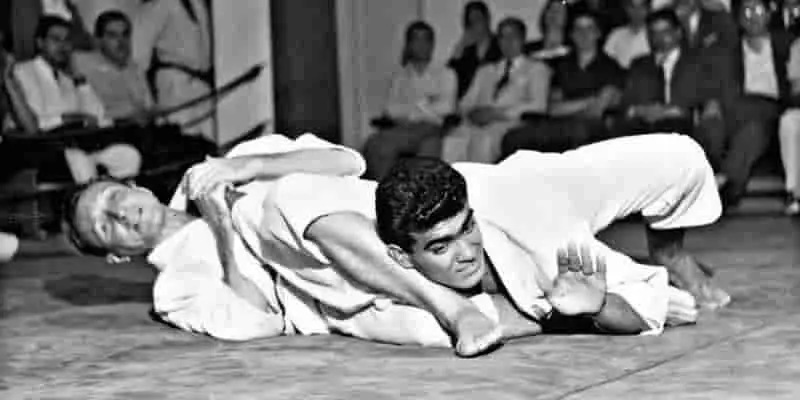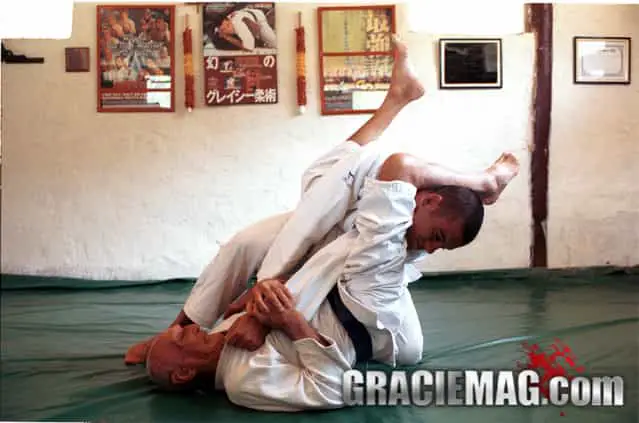Brazilian Jiu Jitsu is one of the most famous martial arts in the world, which became especially known after the UFC. In recent years, the sport has become very popular, with big competitions taking place in several countries. Still, many people don’t know the sport’s history and still confuse BJJ with its predecessor, Japanese Jiu-Jitsu (or Ju-Jutsu). So what is the difference between Brazilian and Japanese Jiu Jitsu?
The Japanese Jiu Jitsu (Ju-Jutsu) focuses on takedowns and traumatic blows and allows the use of weapons. Brazilian Jiu Jitsu is a distance management martial art. It teaches striking and self-defense, but the main goal is using leverage and pressure to control and submit opponents on the ground.
Ju-Jutsu (or Ju-Jitsu) is a martial art that emerged on the Asian continent around 3,600 years ago. In Brazil, it arrived in 1914 where was adapted by the Gracie Family, creating what we know as Brazilian Jiu Jitsu. To understand in detail what are the main differences between Brazilian and Japanase Jiu Jitsu, read on.
Main Differences Between Brazilian and Japanese Jiu Jitsu
The main differences between Brazilian and Japanese Jiu Jitsu are the use of weapons and traumatic blows, taught only in the Japanese version of the art. The Brazilian Jiu Jitsu is an evolution of this fighting style, a distance management martial art focused on self-defense. The main goal of BJJ is overpowering an opponent in the cleanest way possible, giving him the chance to give up without getting hurt too bad. Some say that BJJ does not involve striking, but that’s not true. Punches and kicks are not allowed in competitions, but are essential for self-defense purposes and are taught in Brazilian Jiu Jitsu.
Another major difference between the styles is that Japanese Jiu-Jitsu is more physical: stronger opponents always have benefits. When it arrived in Brazil, only the stronger members of the Gracie Family were allowed to train. Hélio, the creator of the Brazilian version, was a weak individual. After watching hundreds of training sessions of his brothers, he adapted the martial art for his physical biotype. That’s why Jiu-Jitsu is considered a fighting style to empower the weak with the ability to beat stronger and bigger opponents. In this sense, in Brazilian Jiu-Jitsu, the technique is more important than brute force. However, a strong and technical athlete will be way more dangerous.
| Japanese Jiu-Jitsu (Ju-Jutsu) | Brazilian Jiu-Jitsu (BJJ) | |
| Use of Weapons | Yes | No |
| Takedowns | Yes | Yes |
| Punches | Yes | Only for self-defense purposes. Not allowed in competitions. |
| Kicks | Yes | Only for self-defense purposes. Not allowed in competitions. |
| Ground Control | No | Yes |
| Submissions | Only a few | Yes |
A common mistake on this subject is trying to make a value judgment, telling what martial is the best. This is not the point of this article. I don’t even think that there is a martial art that is the best, but some are more effective than others. Either way, this is not the point of our comparison. The goal here is to enlighten important characteristics of both styles and let you decide what is the best fit for you.
Brazilian Jiu Jitsu (BJJ)

When comparing styles and highlighting things about each style, it’s important to list base principles, forgetting a little bit of the competitive side, which usually is just a part of the whole philosophy. Talking about BJJ, we need to understand that the sports side of this fighting style is not everything. For example, as in competitions, striking is not allowed, some may think that BJJ does not teach you how to punch and or defend from striking, which is not true. It’s just a rule for competitions.
About BJJ, it’s fair enough to say that self-defense is the most important pillar. That was the whole point of the Gracie Family, especially from Hélio, the grandmaster of the art that through his incredible vision and capacity for innovation adapted a physical sport into a fighting style that literally anyone can practice and learn. His goal (as a weak individual) was proving that BJJ was so effective that even a weak and little individual could beat stronger and bigger opponents with the right techniques. Another misconception caused by the focus only on the sports side of BJJ is saying that it’s just a grappling or ground-focused martial art. That’s not true. Brazilian Jiu-Jitsu is, above all, a distance management fighting style. And its techniques work equally whether on foot or on the ground, depending on how well the athlete manages the distance from the adversary.
Also, as said before, there are punches and kicks in Brazilian Jiu Jitsu. But they are not taught to be used in sparring or competitions, where the main goal is winning cleanly with technical submissions, giving the opponent the chance of giving up without getting hurt. However, as you know now, self-defense is at the roots of BJJ, and traditional schools dedicate at least 30% of the beginner classes to teaching techniques and skills (including a lot of striking) that can be used in real combat situations. That being said, after the White Belt (Blue Belt on), is fair enough to say that most of the time will be dedicated to teaching ground control and technical submissions. In short, here are some important pillars of BJJ:
- Distance Management
- Self-Defense
- Takedowns
- Ground Control
- Submissions
Japanese Jiu Jitsu (Ju-Jutsu or Ju-Jitsu)
The same way we did with BJJ, we need to focus on the philosophy of this martial art to really understand its pillars and base principles. The first thing to keep in mind is that Ju-Jutsu was not created as a sport, it has emerged from martial concepts used by Samurais, the Japanese warriors, to be used at war.
There are at least three strands for the origin of Jiu Jitsu, but the most widespread is that Jiu Jitsu arose in Japan. Another version says that it arose in India, where it was practiced by Buddhist monks, being taken to China and then to Japan, following the expansion of Buddhism. The third version says that it emerged in China. Despite the divergences as to the origin, there is a consensus that it was in Japan, through the Samurai schools, that the techniques and blows were developed. At that time, Jiu Jitsu emerged as a martial art that differed from others because, according to the Japanese, it worked with self-defense techniques that were linked to the philosophy of Buddhism, based on intelligence, not just brute force. It explains why to these days BJJ and Ju-Jitsu are often called a “Gentle Art”. Despite focusing on combat skills, it’s important to mention that traditional Japanese Ju-Jitsu also involved teaching the use of weapons.
The first registration of the word Ju-Jitsu occurred in 1532, created by Hisamori Tenenuchi, founder of the first Jiu-Jitsu school in Japan. However, at first, Jiu-jitsu was not well seen. This vision only changed after Jigoro Kano started a revolution in old Ju-Jitsu techniques, in the late 1800s. Jigoro Kano, considered the creator of Judo, was a Japanese martial art master, wise man, member of the cultural department, and Ju-Jitsu practitioner. The same way Hélio Gracie made BJJ from Japanese Jiu-Jitsu, Jigoro Kano created his own version, which he called Judo, using fundamentals from the good old Jiu-Jitsu. Some important fundamentals of Japanese Jiu Jitsu are:
- Self-Defense
- Fight With Inteligence, Not Only Brute Force
- Takedowns
- Use of Weapons
- Traumatic Blows
The Creation Of Brazilian Jiu Jitsu

The story of the arrival of Japanese Jiu-Jitsu in Brazil and its subsequent transformation into what we know today as Brazilian Jiu Jitsu is fascinating. It started around 1914 when Mitsuyo Maeda arrived in Brazil, a Japanese Ju-Jitsu master who was also known as “Count Koma”. After traveling through some countries such as the United Kingdom, Mexico, Cuba, and France, Maeda arrived in Brazil doing fight demonstrations. He ended up falling in love with the place and settled in Belém do Pará, a beautiful city in the Northeast of Brazil.
At that time, there was still a lot of confusion about the name of this fighting style. Even in Japan, there were still doubts, since the term “Ju-Jutsu” or even “Kano Ju-Jutsu” was used referring only to the technical part, while the term “Judo”, coined by Jigoro Kano, referred to the philosophical part of the art. Only in 1925 Judo became the official name of the fight by the Japanese government and started being taught in the country’s public schools.
When Maeda arrived in Brazil, the name Judo was not yet official, so he presented his martial art as “Ju-Jutsu.” For Brazilians, it was difficult to pronounce, and in Portuguese, the art began to be called “Jiu-Jitsu”. After some time in the city, Maeda became friends with Gastão Gracie, an influential businessman who helped him settle in Belém. In gratitude, Maeda taught traditional Japanese Jiu-Jitsu to Carlos Gracie, Gastão’s eldest son. Carlos learned from the master for a few years and then took it upon himself to teach his brothers.
The first Gracie School was founded in 1925 in Rio de Janeiro. Carlos and his brothers, at that time, still taught the traditional Japanese Jiu-Jitsu learned from Maeda. Hélio Gracie, the youngest of the brothers, was forbidden to train because he was “too fragile”, would just watch the training sessions. After a long time watching the classes, Hélio realized that he could adapt the techniques used until then, creating his own fighting style, based on his own physical limitations. Hélio began to modify what he observed in his brother’s teachings and was determined to efficiently execute the techniques, modifying them and adapting them to his physical structure.
One day a student arrived to train at the gym with his father, and the only brother who was present was Hélio, who was then willing to teach. In that class, he taught everything according to his Jiu-Jitsu vision, translating into the techniques important principles and lessons based on his own limitations. The student fell in love with art. When he returned to the gym he no longer wanted to train Jiu-Jitsu, but he wanted to train Hélio’s Jiu-Jitsu. From this evolution that emphasized the principles of the lever and the choice of the right moment to attack, pressure, and use of the opponent’s force, among many trials and errors, the Gracie family adapted the art, creating Gracie Jiu-Jitsu, the Brazilian Jiu-Jitsu.
Related Questions
How is Brazilian Jiu Jitsu different from Japanese? Brazilian Jiu Jitsu is the evolution of the Japanese version. While Ju-Jutsu (Japanese) is more focused on traumatic strikes and the use of weapons, BJJ’s main goal is controlling distance and finishing opponents with technical submissions.
Is Japanese Jiu Jitsu effective in a street fight? As a general rule, Japanese Jiu Jitsu is super effective in a street fight, as it combines powerful and traumatic strikes with takedowns and ground control. In traditional Ju-Jutsu schools is common for students to deal with weapons.
Is Japanese Jiu Jitsu still practiced? Japanese Jiu Jitsu is still practiced, but not as much as its evolution: the Brazilian Jiu Jitsu. As BJJ became more popular, it’s hard to find schools that still teach the Japanese version of this martial art out of the Asian continent.
Did Brazilian Jiu Jitsu come from Japanese Jiu Jitsu? Brazilian Jiu Jitsu comes from Japanese Jiu Jitsu (Ju-Jutsu), as an evolution of this martial art. BJJ focus on empowering weak individuals by teaching distance control, takedowns, and technical submissions. It’s the most effective martial art.
